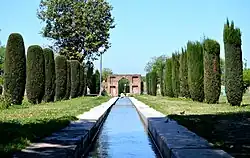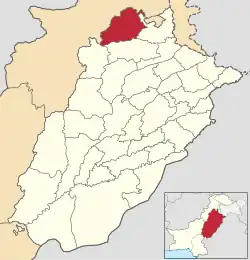Attock
ضلع اٹک | |
|---|---|
     Clockwise from top-left: Inderkot Mosque, Gurdwara Panja Sahib, Begum ki Sarai, Wah Mughal Gardens, Attock Fort | |
 Attock District highlighted within Punjab Province | |
| Coordinates: 33°45′57.6″N 72°21′39.2″E / 33.766000°N 72.360889°E | |
| Country | |
| Province | |
| Division | Rawalpindi |
| Headquarters | Attock |
| Government | |
| • Type | District Administration |
| • Mayor | Malik Tahir Awan, PTI |
| • Deputy Commissioner | Imran Hamid Sheikh (BPS-19 PAS) |
| • District Police Officer | Dr. Sardar Ghias Gul Khan (BPS-19 PSP) |
| Area | |
| • Total | 6,857 km2 (2,648 sq mi) |
| Elevation | 355 m (1,165 ft) |
| Population (2017)[1] | |
| • Total | 1,883,556 |
| • Density | 270/km2 (710/sq mi) |
| Time zone | UTC+5 (PKT) |
| Languages | Punjabi, Hindko, Pashto, Urdu |
| No. of Tehsils | 6 |
| Tehsils | Attock Fateh Jang Hazro Hassan Abdal Jand Pindi Gheb |
| Website | attock |
Attock District (Urdu and Punjabi: ضلع اٹک) is a district in Pothohar Plateau of the Punjab Province of Pakistan. Its capital is Attock city.
The district was created in April 1904[2] by the merging of tehsils of nearby districts. Its former name was Campbellpur. Today the district consists of 6 tehsils: Attock, Fateh Jang, Hazro, Hassan Abdal, Jand and Pindi Gheb.[3]
It is located in the north of the Punjab province, bordered by Chakwal to the south, Mianwali to the southwest, Rawalpindi to the east, Kohat to the west, Nowshera to the northwest, and Swabi and Haripur to the north.
History
The original name of Attock District was Attock. It was changed to Campbellpur after the Commander-in-Chief of British forces Sir Colin Campbell, who rebuilt the city of Campbellpur. The name Attock was restored in 1978.[4]
Demographics
| Year | Pop. | ±% p.a. |
|---|---|---|
| 1951 | 486,043 | — |
| 1961 | 532,845 | +0.92% |
| 1972 | 748,890 | +3.14% |
| 1981 | 876,667 | +1.77% |
| 1998 | 1,274,935 | +2.23% |
| 2017 | 1,883,556 | +2.08% |
| Sources:[5] | ||
According to the 2017 census of Pakistan the district had a population of 1,883,556, of which 490,908 (26.02%) lived in urban areas. Attock has a sex ratio of 1010 females per 1000 males and a literacy rate of 66.91%: 78.70% for males and 55.47% for females. 439,841 (23.35%) is under 10 years of age.[1]
Religion
As per the 2017 census Islam is the predominant religion with 99.51% of the population.[1]
| Religion | Population (1941)[6]: 42 | Percentage (1941) | Population (2017)[1] | Percentage (2017) |
|---|---|---|---|---|
| Islam |
611,128 | 90.42% | 1,877,221 | 99.51% |
| Hinduism |
43,009 | 6.36% | 545 | 0.03% |
| Sikhism |
20,120 | 2.98% | -- | -- |
| Christianity |
504 | 0.07% | 7,699 | 0.41% |
| Others [lower-alpha 3] | 1,114 | 0.16% | 883 | 0.05% |
| Total Population | 675,875 | 100% | 1,886,378 | 100% |
Languages
In the 2017 census 65% of the population identified their first language as Punjabi, 16.5% as Hindko, 14.5% as Pashto and 1.8% as Urdu.[1] In the previous census of 1998, the multiple-choice question did not have an option for Hindko; the percentages were 87% for Punjabi, 8.3% for Pashto and 1.1% Urdu.[7]
The Punjabi dialect of the eastern Fateh Jang Tehsil is called Sohāī̃ and belongs to the Dhani dialect group. The dialects of Pindi Gheb Tehsil (called Ghebi) and of Attock (sometimes called Chhachi) have been classified as part of Hindko.[8]
Tehsils
Union Councils
The District contains a total of 72 Union Councils.[9]
Education
Attock has a total of 1,287 government schools out of which 51 percent (657 schools) are for female students. The district has an enrolment of 224,487 in public sector schools[10]
See also
References
- 1 2 3 4 5 6 7 "District census: Attock". pbs.gov.pk. Pakistan Bureau of Statistics. 2017.
- ↑ Gazetteer of the Attock District 1930, Punjab Government, Lahore 1932. Reprinted version: Sang-e-Meel Publications, Lahore, 1989
- 1 2 3 4 5 "Tehsils and Unions in the District of Attock". National Reconstruction Bureau, Government of Pakistan website. Archived from the original on 9 February 2012. Retrieved 23 April 2023.
- ↑ "Brief History of Attock". Attock Police website. Archived from the original on 27 September 2007. Retrieved 23 April 2023.
- ↑ "Population by administrative units 1951-1998" (PDF). Pakistan Bureau of Statistics.
- ↑ "CENSUS OF INDIA, 1941 VOLUME VI PUNJAB PROVINCE". Retrieved 21 July 2022.
- ↑ 1998 District Census report of Attock. Census publication. Vol. 12. Islamabad: Population Census Organization, Statistics Division, Government of Pakistan. 1999.
- ↑ Shackle, Christopher (1980). "Hindko in Kohat and Peshawar". Bulletin of the School of Oriental and African Studies. 43 (3): 484–86. doi:10.1017/S0041977X00137401. ISSN 0041-977X. S2CID 129436200.
- ↑ "Union Councils of district Attock". Retrieved 23 April 2023.
- ↑ "Punjab Annual Schools Census Data 2014-15". School Education Department, Government of the Punjab website. Archived from the original on 25 August 2016. Retrieved 23 April 2023.
- ↑ Historic district borders may not be an exact match in the present-day due to various bifurcations to district borders — which since created new districts — throughout the historic Punjab Province region during the post-independence era that have taken into account population increases.
- ↑ 1941 census: Including Ad-Dharmis, 2017 census: Including Scheduled Castes
- ↑ Including Jainism, Buddhism, Zoroastrianism, Judaism, (Ahmadi and Sikh in the 2017 census) or not stated
